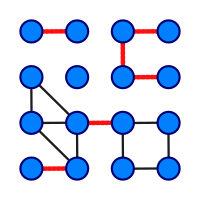
Photo from wikipedia
In a graph $$G=(V,E)$$ , a vertex $$v\in V$$ is said to ve-dominate the edges incident on v as well as the edges adjacent to these incident edges on v.… Click to show full abstract
In a graph $$G=(V,E)$$ , a vertex $$v\in V$$ is said to ve-dominate the edges incident on v as well as the edges adjacent to these incident edges on v. A set $$D\subseteq V$$ is called a double vertex-edge dominating set if every edge of the graph is ve-dominated by at least two vertices of D. Given a graph G, the double vertex-edge dominating problem, namely Min-DVEDS is to find a minimum double vertex-edge dominating set of G. In this paper, we show that the decision version of Min-DVEDS is NP-complete for chordal graphs. We present a linear time algorithm to find a minimum double vertex-edge dominating set in proper interval graphs. We also show that for a graph having n vertices, Min-DVEDS cannot be approximated within $$(1 -\varepsilon ) \ln n$$ for any $$\varepsilon > 0$$ unless NP $$\subseteq $$ DTIME( $$n^{O(\log \log n)}$$ ). On positive side, we show that Min-DVEDS can be approximated by a factor of $$O(\ln \varDelta )$$ . Finally, we show that Min-DVEDS is APX-complete for graphs with maximum degree 5.
Journal Title: Journal of Applied Mathematics and Computing
Year Published: 2020
Link to full text (if available)
Share on Social Media: Sign Up to like & get
recommendations!